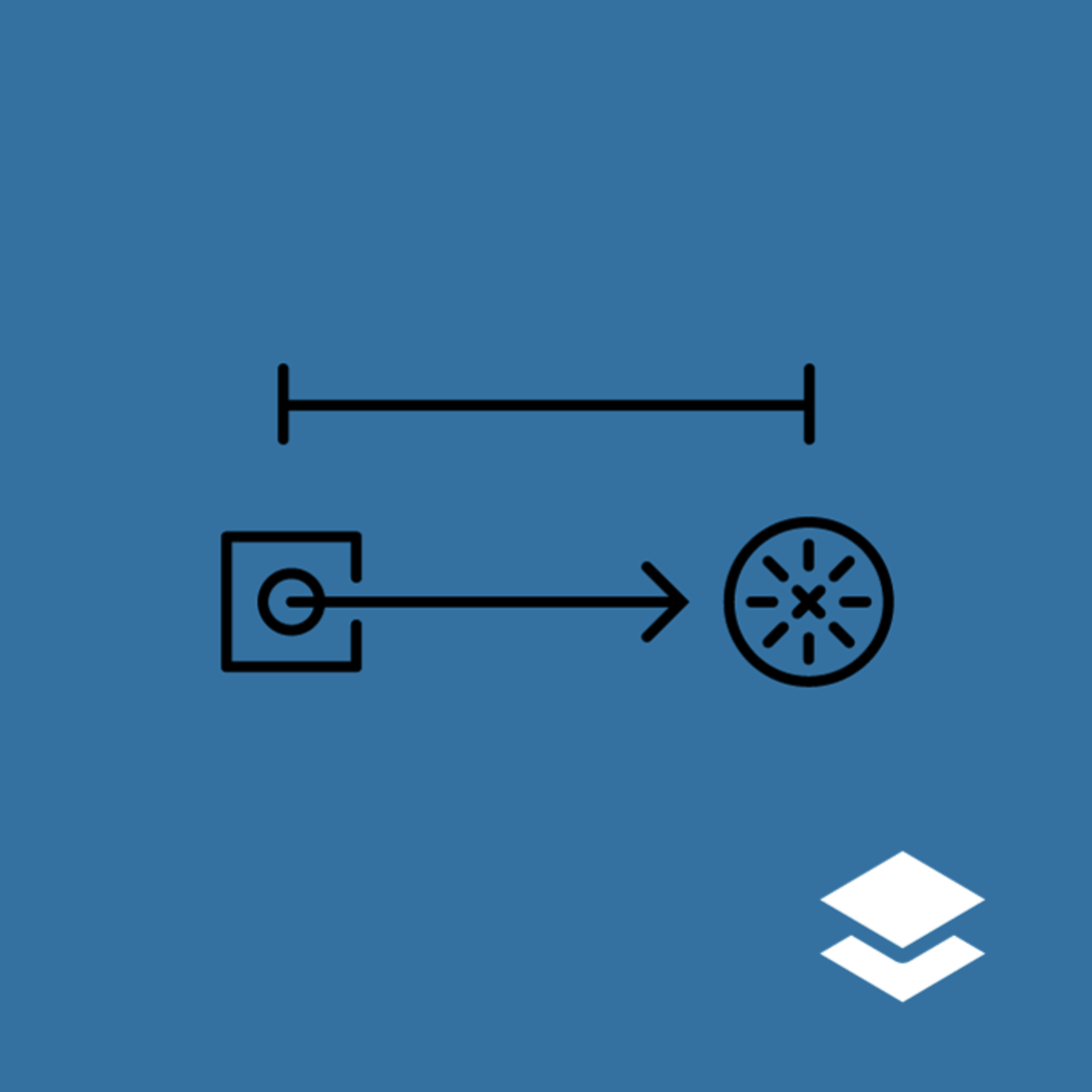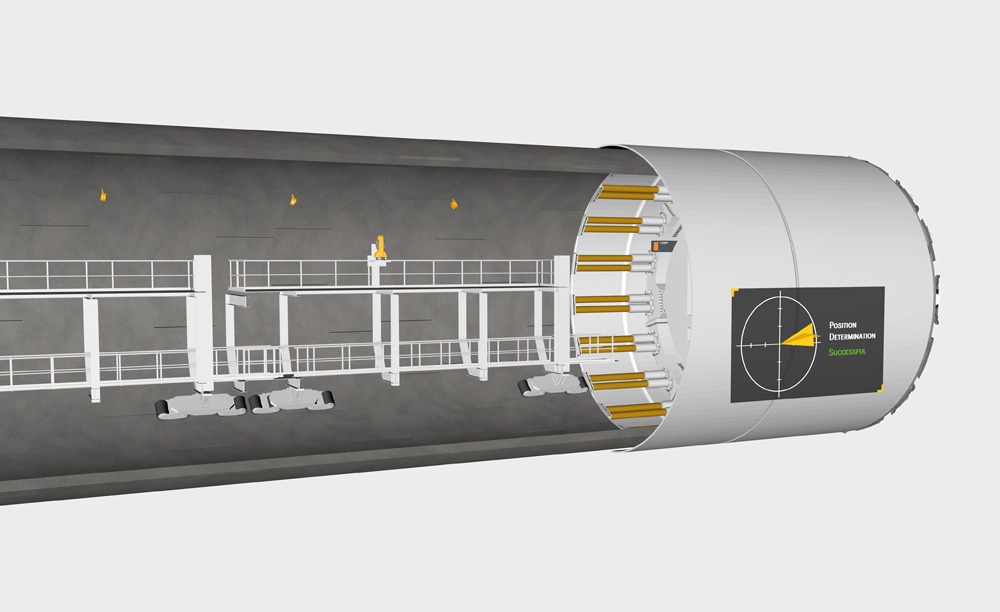
TUnIS.moving station
TUnIS.moving station is an assistance system that enhances navigation systems based on a total station and an active laser target.
Reason why
The purpose of TUnIS.moving station is to determine and calculate all data and information that is necessary for navigating the TBM along the tunnel axis without the total station being attached to the tunnel wall and having to be moved regularly.
Read more
Repeated relocation of the total station on the tunnel wall as tunnelling progresses does not only mean a loss of time and the corresponding cost. Every move always means a risk for people and the device. The more often the total station has to be moved, the more serious the disadvantages – particularly in tight curves. A simpler solution was necessary to increase efficiency and safety.

With TUnIS.moving station, only three cable-free prisms have to be moved. The total station is directly mounted on the gantry of the TBM, moving with the drive. In the first step, the exact current position of the total station is determined using the prisms. In the second step, the current position of the laser target is determined and thus the position of the TBM.
Benefits
- Efficient use of specialist labour
The surveyor no longer has to continuously accompany the advance on the machine, as the recurring modification of total station and console is no longer necessary. This leaves more time for working on other activities. - Material-saving tunnelling
Since heavy total station consoles are no longer required, the segments remain undamaged. The prisms can be attached quickly and easily. - Everything in view, regardless of radius
Because the total station is permanently mounted on the gantry, tight curves can be driven – without loss of sight. - Increased occupational health and safety
Simplified assembly, remote control of the total station via mobile app and reduced danger of looking into the laser beam all ensure better occupational health and safety. - Integrated data access
All navigation data is integrated in real-time into Herrenknecht.Connected for for remote access, analysis, visualisation and combination with other TBM data.
Customer experience
Project: Brasov Sighisoara Railway
“Due to the structure of the TBM and the equipment placed at the gantries the narrow laser window was a great concern. Thanks to TUnIS.moving station, however, this challenge was successfully overcome.”
Ali Kemal Ozturk, Surveyor Manager
Aktor
Read more
Why did you choose TUnIS.moving station as assistance system to the main navigation system TUnIS Navigation TBMLaser – were there alternatives/competitive solutions?
“Reliability, that’s the first reason VMT has been chosen. VMT Tunnel Navigation systems have proven themselves reliable and steady within any kind of tunnels I have worked in. Hereupon improvement of tunnel surveying perspective and adaptation to new requirements in tunnelling is always at company’s agenda. VMT Navigation system updated with moving station became the most convenient Tunnel Survey System. In my case, at “Brasov Sighisoara Railway Project” in Romania, TUnIS.moving station is beyond than assistance system. Due to structural complexity of TBM’s there no other Survey-Navigation system could be an alternative.”
Which were the main arguments with which TUnIS.moving station could convince finally?
“There wasn’t any argument necessary to convinces us: system functions are clear,
results are evident.
Reducing of working time and simplicity of procedure were beyond my initial thoughts. Accuracy is also accomplished for requested precision. So now planning to transfer remaining two machines, not only the advantages mentioned above and cost reduction for project have been significant. Relocation of manpower for remaining activities became easier and effective.”
Could TUnIS.moving station generally fulfil the expectations – did it perform like it was expected/ordered/bought?
“VMT Systems exceed my expectations, consistent improvement of systems fulfils all requirements, personally and professionally.”
Which were the main benefits that the system delivered → are there any “hard figures” that show/proof the benefits like cost reductions, reduction in staff/time etc.?
“Narrow Survey Laser Window was our concern, due to structure of TBM and equipment placed at the gantries, Total Station bracket could not be installed as supposed to be in best position.
- Moving Station cleared this issue definitively.
- Almost “zero” cost of consumables for the total station consoles maybe sounds small but almost half cost of Moving Station at 24 km of tunnels.
- Moving forward of spherical targets can be done with Junior Surveyor. Lead Surveyor tasks can be reoriented for supervisory controls.
- Total number of TBM Surveyor was decreased to 4 from 7, in 4 TBMs.
- Duration of each TBM survey work was reduced from 2 hours to 25 min. in daily basis.
- Heavy labour for Total Station installations is no longer necessary.”
How do you judge the collaboration with VMT: in negotiation & consulting phase, during implementation, during the project?
“Initial communication was helpful and creative. VMT’s international Know-How helps to improve our vision. Implementation and operational support were swift, and all our requests were fulfilled promptly and to our satisfaction.”
Were there any advantages in workflow (synergy effects) in using several VMT products in the project – in terms of functionality/support etc.?
“VMT’s approach for solutions and ease of understanding the systems help deliver the project as intended.”
Do you have any proposals for improvement of our technologies?
“I am only looking forward to seeing the new improvements.”
Would you opt again for TUnIS.moving station and VMT as partner?
“I would very much prefer to work with VMT systems in the future and do not hesitate to recommend them to all who are looking for reliable and steady Tunnel Survey Systems.”
Any further comments?
“Observations:
- Increasing the numbers and distribution of spherical targets enhance the precision of positioning.
- Specially in sharp curves, limitation of “Survey Laser Window” and frequently shifting total station bracket have been eliminated.
- Fixed position of total station prevents unintentional hazards of instrument compared to bracket installation.
- Easier and safe work.
- Orientation of TBM Operator for this system was short and easy.”
Project: Thames Tideway
“The advantages of the system can be accredited mostly for improved time efficiency resulting in cost saving.”
Roy Behrend, Chief Surveyor
BAM Nuttall, Morgan Sindall, Balfour Beatty Joint Venture
Read more
The science of tunnel navigation is an area of technology that over the decades has moved from the simplest of surveying techniques to the modern complex IT supported systems we have today. VMT has always been at the forefront of such developments and has recently introduced the latest innovation TUnIS.moving station.
TUnIS.moving station is an assistance system that enhances a laser and target-based navigation system. With TUnIS.moving station, the total station is not mounted on the tunnel wall, but travels on the gantry of the tunnel boring machine (TBM).
TUnIS.moving station determines and calculates all data and information that is necessary for navigating the TBM along a tunnel axis. The high information content of the data displayed ensures optimum control of the machine position and thus helps to maintain a uniform shield run with small deviations from the desired route. The position and tendencies are continuously displayed to the shield operator. This allows vertical or horizontal curves to be easily and precisely controlled.
Three prisms installed on the tunnel wall with an active electronic laser target in the shield of the TBM are used for exact determination of position. In the first step, the exact current position of the total station is determined using the prisms. In the second step, the current position of the laser target is determined and thus the position of the TBM.
This system has recently run very effective trials on the Thames Tideway Tunnel project in the UK. The trials were so successful that the tunnelling operation has now been moved onto this system replacing the existing VMT standard navigation system for the remainder of the current tunnelling operation.
Subsequent to the trial Roy Behrend, Chief Surveyor for the BAM Nuttall, Morgan Sindall, Balfour Beatty joint venture (BMBJV) constructing the west section of the tunnel was interviewed by VMT’s Steve Wojtkowiak to obtain his views on the TUnIS.moving station.
Why did you choose the VMT TUnIS.moving station product when there are alternatives / competitive solutions?
“BMBJV was using VMT’s original fixed position Total Station Navigation System (TUnIS Navigation TBMLaser) which uses two stationary inter-visible brackets mounted on the Ring Segments. These brackets, the Total Station as well as the reference prism were moved and relocated as the TBM advanced.”
What where the main arguments that convinced you to go with the VMT product?
“VMT installed and tested the Moving Station guidance system on our TBM. The Moving Station and the original fixed station guidance systems were operated simultaneously to check for coincidental position accuracy and system comparison. The advantages of the Moving Station were evident and the system has been implemented and adopted for the remainder of the tunnel drive.”
Did the VMT solution generally fulfil your expectations? Did they perform as expected?
“Yes, all expectations were fulfilled by VMT.”
What were the main benefits that the systems delivered and do you have any ‘hard data’ that highlights the benefits, for example cost reductions, reduction in staff/time etc.?
“BMBJV was about 50% completed with construction of the 7 km TBM drive when the TUnIS.moving station was implemented. The advantages of the system can be accredited mostly for improved time efficiency resulting in cost saving. These efficiencies included:
- Total station fixed brackets are no longer required to be drilled and bolted onto the Ring Segments. This is a saving of time for the Engineer to drill and mount about 270 bracket positions for the remaining 3,500 m of the tunnel drive. Also, there is a time saving by not having to repair the drilled holes once the station position is changed, so the original finish of the Segment is maintained.
- With the original system the Total Station continuously measured to the active laser target unit (ALTU) to update the TBM position during the advance. With the TUnIS.moving station, a geometrical TBM position is only required once before the start of each advance when the total station is stationary. This allows for free movement of the TBM crew and no longer provides a conflict with staff blocking the laser beam during the advance especially with our TBM’s gantry design.
- With the TUnIS.moving station, the Engineer updates the TBM position remotely by use of a mobile device App and WiFi data communication with the TUnIS software. This App allows ‘hands free’ Total Station operation and position calculation which is efficient and easy to use.
- With the TUnIS.moving station, the Total Station nor the radio modem require external battery charging and replacement. It is powered continuously from mains power.
- The TUnIS.moving station did not reduce the staffing requirement. The Engineer still operates the guidance system as before, but the improved time management for the system operation has made it a less onerous task.”
How do you rate your collaboration with VMT in terms of:
- in negotiation/consulting phase
- during testing phase on TBM and later implementation
- support during the project
“Communication was really good with VMT for the testing and implementation of the system. There is always immediate ongoing support for VMT’s navigation systems and TUnIS software. Support is also available remotely online via Team Viewer.”
Do you have any proposals for improvement of our technologies?
“Not at this time.”
Would you opt for a VMT product solution again and work with VMT as a partner?
“The TUnIS software package is well developed and menu systems allow for ease of use. The system is very well supported by VMT. VMT Support Engineers have remote access to the system which allows for easy system maintenance and testing. I would not hesitate to recommend or use VMT products again.”
Project: Grand Paris Express
“The surveyor also saves time in the field, since it is faster to install a simple prism than a huge console to be handled by two people. He can take care of it alone without asking for assistance.”
Christophe Cottanceau, Surveyor
Implenia AG
Read more
Why did you agree to the transformation from the standard system TUnIS Navigation TBMLaser to TUnIS.moving station?
“Our former tunnel director suggested to try this system. I found the principle interesting; so, why not have a go? I like working on new technologies likely to improve the surveyor’s working conditions.”
How were your TBM operators effected by the TUnIS.moving station system? What is the opinion from them?
“TBM operators are not that open for changes. In the beginning, they were skeptical, since they were not familiar with this system. They had a system that worked highly precise and well and now they were given a system that needs a different interpretation of the accuracy with a slightly reduced but still sufficient precision which had position jumps at the beginning.
By explaining how to use this system, by discussing with the shift engineers and thanks to periodic system updates by VMT, it was possible to clearly improve the accuracy of the moving station and along with this the acceptability among the TBM operators.”
Which were the main arguments with which VMT systems could convince finally?
“This system is beneficial for the production teams since they no longer need to intervene on the total station whether to change the battery or relocate the device and the bracket. To them, this is one less thing to worry about. Depending on the TBM’s configuration, using the moving station may be more interesting than the traditional system. In our case, the window in which to act was somewhat reduced as a result of the change of position of a mortar bucket. It also sent vibrations onto the total station which, in the long run, can harm the device. Today, the problem is solved. The interest is even greater for surveyors, since the system provides flexibility for relocating the backsight prisms and, in most cases avoids changing the consoles (which are very heavy and impossible to install alone).
The surveyor also saves time in the field, since it is faster to install a simple prism than a huge console to be handled by two people. He can take care of it alone without asking for assistance.”
Could these VMT solutions generally fulfill the expectations – did they perform like it was expected/ordered/bought?
“In the beginning, the TUnIS.moving station generated jumps in the position of the machine due to vibrations and suboptimal use. Since then, we have carried out several adjustments with the pilots, shift engineers and VMT, and today the system gives a smooth navigation that comes close to the traditional system. This system has been accepted by almost everyone.”
How do you judge the collaboration with VMT?
“Whether during installation of the navigation system equipment, during training on the TUnIS software or while resolving technical problems, the VMT teams have worked with us since the start of the project. The engineers listen and respond to the needs, take our remarks into account and improve the navigation system in order to increase its reliability and precision.”
Do you have any proposals for improvement of our technologies?
“I have already given you my feedback and some ideas during your last visit for improving TUnIS.moving station and TUnIS.mobile app. Like for example:
- We can’t do calculation of position during the ring building because of vibration of the conveyor, so we do it at the beginning.
- If the total station can measure the ALTU before monitoring prism it’s better because the navigation will be ok, the monitoring is less important.”
Would you opt again for our product solution and VMT as partner?
“The navigation system is intuitive and works well, and so I recommend it.”
Downloads
Our product info gives an overview of the features and benefits of TUnIS.moving station. Moreover, our customer experiences provide valuable insights into working with the system.
Customer experiences
Product info
- TUnIS.moving station
PDF-Document
Contact
For more information or project inquiries do not hesitate to contact our expert.
-

Regional Sales Manager

Maximilian Vollmer